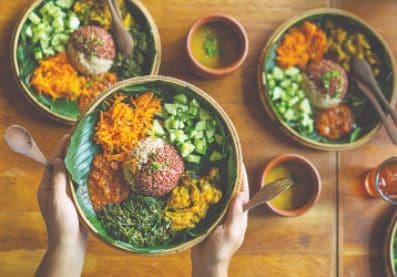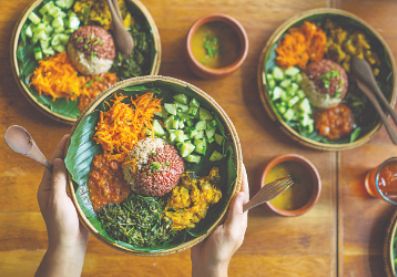Can you imagine Indian food without chillies or tomatoes? Or dosas and samosas bereft of potatoes? Only 500 years ago, this is what Indian food looked like. Dosas in 16th-century Karnataka were filled with a mixture of plantains, salt, pepper, curry and coriander leaves, and ghee, and not with the famous masala potato mix. According to the Ni’matnama Manuscript of the Sultans of Mandu, which contains recipes from the 15th century Malwa Sultanate, the royals enjoyed samosas stuffed with a combination of minced meat and aubergine, perfumed with saffron and rosewater. Half a millennium ago, ingredients such as potatoes, maize, chillies, peanuts, cashews, papayas and pineapples featured nowhere in Indian cuisine. They were yet to make their journey to the subcontinent from the Americas. [caption id=“attachment_6329241” align=“alignleft” width=“397”]  Image: Shutterstock[/caption] At the end of the 15th century, two famous Iberian expeditions set sail to explore a sea route that would take them straight to the realm of spices — India. During the Middle Ages, spices had been a luxury food in Europe, imported via intermediaries in the Middle East from India and Southeast Asia. The Europeans, however, did not know how to get to the source of these precious spices and were keen to change the status quo. One of the expeditions seeking to find a sea route to the land of spices was that of Christopher Columbus. Instead of India, this expedition landed in the Caribbean in 1492. As there had not been any exchange between the ‘Old World’ and the ‘New World’ for hundreds of years, the vegetation of the Americas was quite different to what had developed in Europe, Africa, or Asia. When the Spanish colonised large parts of South America during the 16th century, they brought back some indigenous American plants to Europe, including the now-beloved tomato and potato. In 1497, another expedition left the Iberian Peninsula, looking for the sea route to India. The fleet, headed by Vasco da Gama, sailed under the Portuguese flag and reached Calicut (Kozhikode) in 1498. In the subsequent decades, the Portuguese strived to establish a foothold in India, and by the 1530s they had consolidated their rule over Goa. With them, the Portuguese brought some of the plants that they had themselves just acquired from the Americas via the Spanish and their own colony in contemporary Brazil. The Mughal emperor Akbar, a connoisseur of fruits, showed great interest in some of the new delicacies and made pineapples and guavas mainstays of the imperial kitchens. So much did he enjoy the pineapple that the sweet fruit was procured for ten times the price of a mango at the market. By the time of Jahangir, the emperor’s gardens in Agra already grew thousands of pineapples. Not all of the new plants became popular immediately, though. One late starter was the chilli. Black pepper remained an important source for heat in northern Indian food until the 18th century, which was when chillies slowly started to make an appearance in the cuisine of the nobility. Pepper had been cultivated in Bengal and on the Malabar Coast in the preceding centuries and had been an important and valuable trade good. After the Portuguese arrival in India, chillies were first introduced to Goa, from where they spread to South India. When the army of the Maratha king Shivaji moved north to challenge the Mughal Empire during the 17th century, the chilli was also introduced to north India. According to legend, the Mughal army could only be defeated because the Marathas’ consumption of chillies turned them into particularly fiery adversaries. At first, chillies were used to prepare pickles and chutneys, adding another layer of flavour to the pungent relishes that were immensely popular in the 16th century, and were then incorporated into various other preparations. Today, India is the largest producer of red dried chilli in the world. A second wave of adopting plants originating in the Americas occurred with a push from the British. While starchy vegetables such as the potato, sweet potato, and cassava were cultivated in India by the 16th century, they were far from staples. Indeed, according to records, when the British governor of Bombay received ‘a very acceptable present’ of a dozen pounds of potatoes in the late 18th century, he was so delighted that he organised a high society dinner party to share this ‘rare vegetable’. Then, in the 19th century, the British started a campaign to grow South American food plants in India. Utsa Ray in her book Culinary Culture in Colonial India explains that while the colonial government of Bengal claimed it was promoting ‘scientific’ and ‘modern’ agriculture, its efforts were informed by racist ideas of Indian inferiority. They sought to ‘civilise’ the Bengalis by advocating for the cultivation of plants that were purportedly superior to local crops. The results were mixed: while the attempt to replace Indian rice varieties with American types failed spectacularly, the cultivation of potatoes flourished and the vegetable became an everyday starch. According to the Food and Agriculture Organisation, by 2013 the average consumption of potatoes per capita reached 24 kg per year in India, with a rising trend. The potato was not the only ingredient to get a boost from the British attempt to ‘modernise’ agriculture. Cauliflower, okra, and tomato also proliferated. Today, Indian cuisine would be almost unrecognisable without these ingredients. Of course, the native population did not just adopt the new ingredients as instructed by the British authorities. Rather, they responded with a mixture of curiosity and adherence to tradition. The new foods found favour during the 19th century via an emerging scene of British-style hotels and restaurants, where the middle classes could try out unfamiliar dishes. Eventually, these ingredients found their way to domestic Indian kitchens, where cooks adapted British recipes to suit the Indian palate. When British colonial officers returned home after their service in India, they brought back a taste for anglicised Indian food to Europe. Nowadays, various styles and adaptations of Indian food are beloved in Europe and all over the world. Many popular preparations heavily rely on ingredients incorporated into Indian cookery in the last 500 years, particularly potatoes, chillies, and tomatoes. From this brief history, we can see how Indian cuisine has had a global flavour throughout history, constantly changing by absorbing new ingredients and cooking styles in a truly multicultural way. (Anil Paralkar is a PhD candidate at Ruprecht-Karls-University Heidelberg and specialises in food history)
Black pepper was the main source for heat in northern Indian food until the 18th century, which was when chillies slowly started to make an appearance
Advertisement
End of Article


)

)
)
)
)
)
)
)
)



